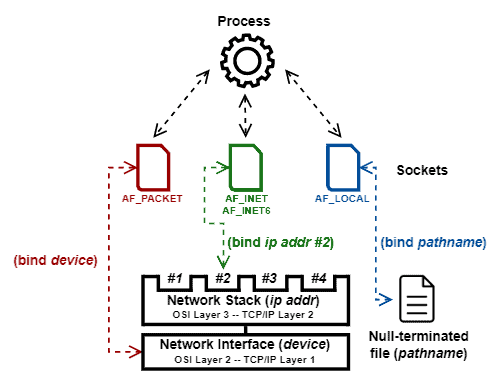1. 简介
Socket 是一种网络资源,用于进程间通信。一个使用 Socket 的应用通常会涉及多个生命周期操作,例如 bind、listen、send、receive 和 close。
本文将重点讲解 Socket 的绑定(bind)操作,包括其作用、使用方式以及一些常见注意事项。
2. Socket 基础知识
Socket 是两个进程之间通信的端点(endpoint),无论这两个进程是否运行在同一台机器上,Socket 都能实现它们之间的通信。在 TCP/IP 网络中,这种 Socket 通常被称为 网络 Socket 或 Internet Socket,它工作在 TCP/IP 协议栈的应用层和传输层之间。
常见的 Socket 类型有三种:
- ✅ Datagram(数据报)Socket:基于 UDP 协议,无需建立连接即可进行通信,适用于对实时性要求高的场景,如视频会议。
- ✅ Stream(流)Socket:基于 TCP 协议,通信前需完成三次握手建立连接,确保数据可靠有序传输。
- ✅ Raw(原始)Socket:绕过传输层协议,直接操作网络接口的数据包,常用于开发抓包工具或网络监控程序。
Socket 的类型决定了其通信方式以及生命周期操作的行为。例如 bind、close、shutdown 等操作的具体行为会根据类型不同而有所差异。
此外,创建 Socket 时还需要指定协议族(protocol family),这决定了 Socket 地址的格式。常见的协议族有:
AF_INET:IPv4 地址 + 端口号AF_INET6:IPv6 地址 + 端口号AF_LOCAL:本地通信,使用文件路径作为地址AF_PACKET:用于在链路层直接操作原始数据包
3. Socket 绑定操作
Socket 创建后,是没有绑定地址的。bind 操作的作用就是为 Socket 分配一个地址,以便其他进程可以通过这个地址与它通信。
绑定地址前,需要根据 Socket 的协议族选择合适的地址格式:
AF_INET:IPv4 地址 + 端口AF_INET6:IPv6 地址 + 端口AF_LOCAL:文件路径AF_PACKET:网络接口名
绑定完成后,Socket 就可以开始监听(listen)连接或接收数据了。
下图展示了不同协议族绑定地址的示例:

3.1 绑定操作的注意事项
实际开发中,绑定操作需要注意以下几点:
- ✅ 服务器端通常需要显式绑定地址:在 C/S 模型中,客户端需要知道服务器的地址才能发起连接,所以服务器端必须绑定一个固定的地址。
- ✅ 客户端通常无需显式绑定地址:操作系统会自动为客户端分配一个临时端口。
- ⚠️ 某些场景下客户端也需要绑定地址:例如,服务器只接受来自特定 IP 或端口的请求,此时客户端必须显式绑定地址。
- ✅ 特殊地址绑定技巧:
0.0.0.0(IPv4)或::/0(IPv6)表示监听所有网络接口- 端口为
0时,系统会自动分配一个可用端口
4. 示例代码
以下是一个简单的 TCP 服务器绑定地址的 Java 示例:
import java.io.IOException;
import java.net.InetSocketAddress;
import java.net.ServerSocket;
public class SocketBindingExample {
public static void main(String[] args) {
ServerSocket serverSocket = null;
try {
serverSocket = new ServerSocket();
// 绑定地址和端口
serverSocket.bind(new InetSocketAddress("0.0.0.0", 8080));
System.out.println("Server is listening on port 8080");
} catch (IOException e) {
e.printStackTrace();
} finally {
if (serverSocket != null && !serverSocket.isClosed()) {
try {
serverSocket.close();
} catch (IOException e) {
e.printStackTrace();
}
}
}
}
}
5. 总结
Socket 的绑定操作是建立网络通信的关键步骤。通过 bind,我们为 Socket 分配了一个地址,使其可以被其他进程访问。绑定地址时,需要根据协议族选择合适的地址格式,并注意绑定的时机和方式。
在服务器端,绑定是必须的;而在客户端,通常由系统自动分配地址。理解 bind 操作的机制和注意事项,有助于我们写出更健壮、高效的网络通信代码。